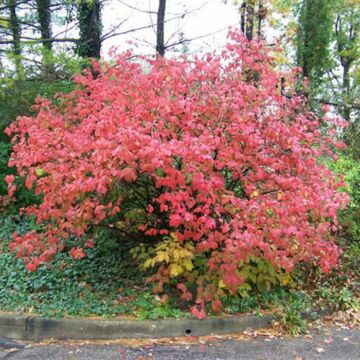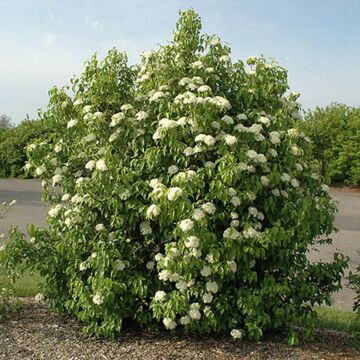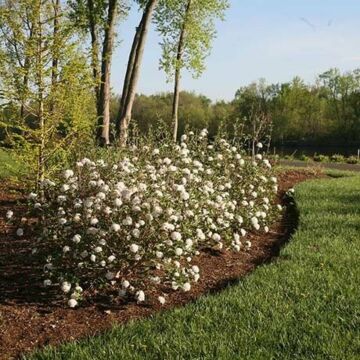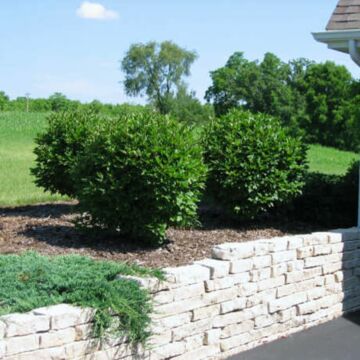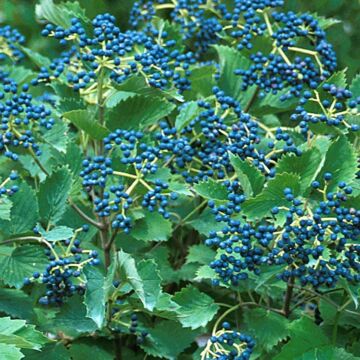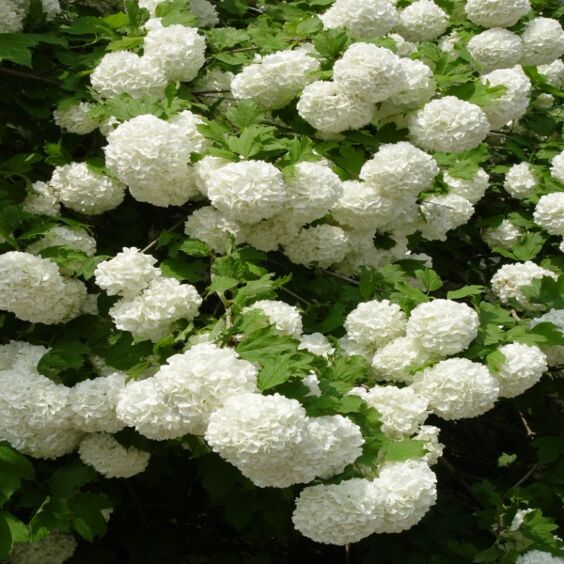
Growing zones
See Zone Map >Status: In stock
Beyond its springtime appeal, the Snowball Bush Viburnum transitions into autumn with lovely reddish-orange foliage, adding seasonal interest to your landscape. This cold-hardy shrub is suitable for a wide range of climates, demonstrating resilience and maintaining beauty from early summer through the changing seasons.
Please note: #5 containers cannot be shipped to Arizona, California, Idaho, Montana, Nevada, Oregon, Utah, Washington due to size restrictions.
- Sun, Part Sun/Shade
Mature Plant Size (H x W): 8-10' x 8-10'
Bloom Season: Spring
- Attracts Bees
- Attracts Birds
- Stone Mulch
- Attracts Butterflies
- Cut Flower
Planting & Care for Snowball Viburnum Deciduous Shrub
Preparation
- One of the most distinctive features of the Snowball Bush (Viburnum opulus “Roseum”) is its large, globular clusters of white flowers that resemble snowballs.
- The flower clusters can reach up to 8 inches in diameter and appear in late spring to early summer.
- Prune in April and July. Trim shoots lightly in early spring.
- Plant in March, May – November.
- Viburnums need at least half a day’s full sunshine to prosper.
- Shield large-flowering varieties from cold wind.
- These shrubs prefer well-drained soil enriched with well-rotted organic matter several weeks before planting.
- In light soils that parch quickly, mulch in spring with moisture-conserving, bulky organics to keep roots cool and active.
Opening Plant Material
- Bare Root - Cut open the bundle (top and roots are tied) and separate all the plants. Soak roots in buckets of water until planted. Each plant type will be labeled separately for identification. Do not expose the roots to the sun. They should never dry out. Keep roots covered. All bare-root plants must be trimmed when planted.
- B&B - Soak the root ball very well. Dig a hole at least 6" wider and no deeper than the size of the ball on the plant. Rotate the plant to the proper position. Never lift or move trees by the tops.
Planting Bare Root
- Plant bare root plants in fall. A reliable indicator that you can still plant is if the ground remains workable; if so, you're good to go. If a hard frost is expected, be sure to hold off on planting.
- Dig a hole at least 6" wider and the same depth as the root mass. The crown or graft of the plant should be slightly higher than ground level where it was grown at the nursery.
- Trim off the broken roots and branches.
- Place fertilizer packets in the hole (if purchased). Do not place other fertilizers in the planting hole. *Use Our Recommended Fertilizer.
- Spread the roots and fill halfway with soil, then water until soil settles completely saturating the soil and planting pit.
- Re-adjust the plant and fill the hole with the rest of the soil.
- Back fill the balance of the soil and water well.
Planting B&B Trees
- Plant B&B trees in spring or fall. A reliable indicator that you can still plant is if the ground remains workable; if so, you're good to go. If a hard frost is expected, be sure to hold off on planting.
- Notice where the base of the trunk flairs out from the tree. This is called the root flair. This root flair should show when the tree is planted. If necessary, add soil under the ball so the root flair is exposed.
- Place fertilizer packets into the bottom of the hole (if purchased). *Use Our Recommended Fertilizer
- Backfill ½ of the hole with soil and completely saturate the soil with water.
- Cut and remove twine once the tree is straight and located as desired. Then, remove or bend back the top of the metal basket. Lastly, remove the exposed burlap from the top of the ball.
- Fill the hole to the top of the ball with soil, then soak well with water and let settle.
- The top of the root ball should be visible and slightly higher than the soil around it.
- Add mulch on top of the soil, making sure not to put mulch against the trunk or stems.
Planting Containers
- Plant in March, May – November.
- Slide the plant from the pot by tapping on the bottom of the pot.
- With a shovel or knife, trim the bottom 2" off the root ball for plants in plastic containers.
- Rotate the plant to the proper position. Never lift or move plants by the tops.
- Place the root ball in the hole.
- Notice where the base of the trunk flairs out from the tree. This is called the root flair. This root flair should show when the tree is planted. If necessary, add soil under the ball so the root flair is exposed.
- Place fertilizer packets into the bottom of the hole (if purchased). *Use Our Recommended Fertilizer.
- Backfill the hole with soil, making sure the top of the root ball is visible and slightly higher than the soil around it.
- Firm the soil around the plant. Water well to settle soil around the root ball.
Pruning - After Planting
- Bare Root - Prune ALL bare root plants to reduce transplant shock and ensure success. Pruning should take place either before planting or as soon as possible afterward. All pruning should be done with sharp pruning shears.
- B&B - While it is not crucial for balled and burlapped (B&B) plants to be pruned immediately after planting, a light pruning to shape, remove any broken branches damaged during shipping, or thin out a densely branched plant can aid in the transplanting process and improve the appearance of your new planting.
Pruning - Throughout the Season
- Prune in April and July. Trim shoots lightly in early spring.
Watering - After Planting
- Plants typically take approximately 6 weeks to establish new roots in your soil. During this period, water plants as often as every 2-4 days at the start and at least a minimum of once per week.
- Beyond the 6 week establishment period, water once per week, unless rains occur.
- Stick your finger 3” into the soil to check soil moisture.
Watering - Throughout the Season
- After the first season, plants should only be watered during extended periods without rain.
- The easiest way to tell if your plants need water is to touch the soil around the roots. If it is moist, there is no need to water. If it is dry, give it a good soaking with the hose end (no nozzle), watering the soil only, not the leaves.
- Stick your finger into the soil around 3” to check soil moisture.
Frequently Asked Questions
Discover helpful gardening tips and insights in our FAQs, featuring McKay Nursery's Snowball Bush Viburnum.
1. How much sunlight does the Snowball Bush Viburnum need?
The Snowball Bush Viburnum thrives in full sun to partial shade. For optimal flowering, plant it in a location where it can receive at least 6 hours of direct sunlight daily. While it can tolerate partial shade, too little sunlight may reduce the number and size of blooms.
2. When does the Snowball Bush Viburnum bloom?
The Snowball Bush Viburnum typically blooms in late spring. The exact timing can vary based on your climate zone, but gardeners can generally expect these flowering shrubs to showcase their large, snowball-like blooms from May to June.
3. Can the Snowball Bush Viburnum be used as a hedge?
Yes, the Snowball Bush Viburnum can be used as a hedge or a privacy screen. Its dense growth habit and height, which can reach up to 8-10 feet, make it an excellent choice for creating natural borders or adding privacy to your garden space.
4. Is the Snowball Bush Viburnum the same as the Chinese Snowball Bush?
No, the Snowball Bush (Viburnum opulus “Roseum”) is different from the Chinese Snowball Bush (Viburnum macrocephalum). While both are called "snowball bushes" due to their similar-looking blooms, they are distinct species. The Viburnum opulus “Roseum” does not produce fruit, whereas the Chinese Snowball Bush might produce fruit under certain conditions.
5. What should I do if my Viburnum Shrub doesn't bloom?
If your snowball bushes are not blooming, ensure they are getting enough sunlight; they need full sun to partial shade to bloom well. Also, avoid over-pruning, as this can remove the current year's blooms. Snowball Bush Viburnums bloom on old wood, so any pruning should be done immediately after flowering to avoid cutting off next year's buds. If the issue persists, consider soil testing to see if your plant lacks any nutrients and adjust your fertilization accordingly.
Upgrade Your Landscaping with McKay Nursery
At McKay Nursery, our expertise spans over a century in the horticulture industry, enabling us to offer an exquisite selection of plants, including the stunning Snowball Viburnum. Nestled in Waterloo, Wisconsin, our nursery is committed to cultivating vigorous and flourishing plants. Choosing us for your gardening needs ensures you receive only the highest quality plants, each backed by our thorough warranty. Our exceptional packaging guarantees that your Snowball Viburnum arrives in impeccable condition, poised to enhance your garden's beauty. Should you need advice or further assistance, we are just an email or phone call away at [email protected] or 920-478-2121.
Planting & Handling Help
Download our Planting and Handling Guide below to plan for a successful arrival and install of your plants. Be sure to water all plants as soon as they arrive and every day until you’re ready to plant. Keep any bare root bundles in a shady, cool spot with the roots covered at all times.


Learn More
Watch our videos on handling bare root plants, how your order is prepared for shipment and more.


Plant Sizing
What is the difference between Containers, Grow Bags, Bare Root, and Balled & Burlap (B&B)?
Shipping Times


Our FedEx and local shipping times depend on two factors, one is by the region and the second is the type of product being shipped. For example, small fruits are only shipped in spring, but majority of our perennials are shipped from spring until fall. Keep in mind the dates below act as a general guide. Due to unpredictable weather, staffing, inventory and industry demands these timelines can change. Therefore, we cannot guarantee any of these times.
Shipping Dates by Region*
Northern Cold Region: April 22nd - November 7th
Northern Region: April 15th - November 7th
Middle Region: April 1st - November 7th
Southern Region: March 15th - November 7th
Local Delivery (small radius from Waterloo, WI): April 22nd - November 7th
Shipping Dates by Season*
Spring Shipping: Region Start Date (above) - May
Fall Shipping: September - November
Due to unpredictable weather, these times may vary. Some varieties are exceptions due to heat and plant health reasons. Enter your shipping zip code at the top of this page and be sure to check the shipping information on each product before you add it to your cart. If the product is too large or restricted in your state, you will not be able to checkout with that item in your cart.

